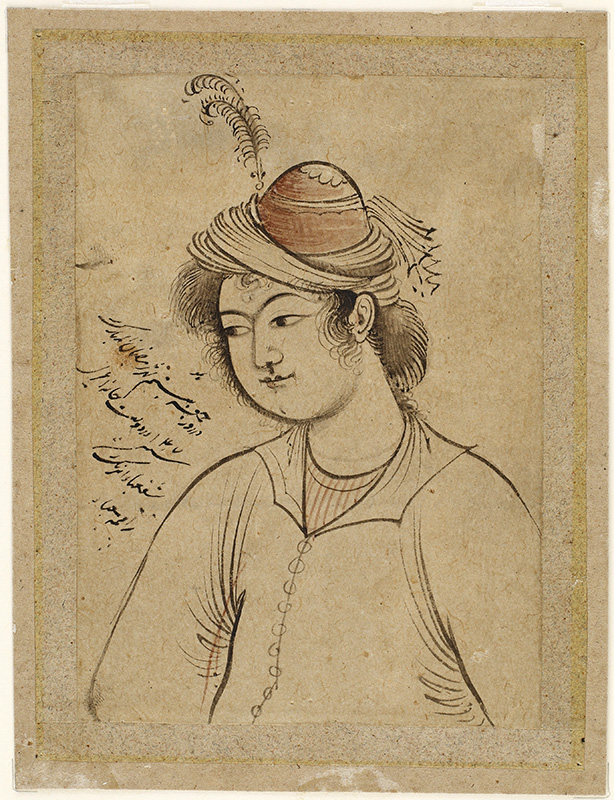Moʿin Moṣavver | Individual Drawings and Paintings
Drawing 1638.1
Young Man Wearing a Hat with a Feather
Location: Smithsonian Institution, Freer Gallery of Art, no. F1953.57; Purchased Charles Lang Freer Endowment.
Formerly in the Sarre Collection, Berlin.
Ink drawing touched with color, on paper: (H x W) 11.6 x 8.4 cm.
Signature: Signed and dated 1[0]47/1638.
Inscription
On the left: hu! dar ruz-e jomʿa bistom-e šahr-e ramażān al-mobārak sana 1[0]47 dar dowlatḵāna . . . šaf 'abā’(?) ābrang šod. raqam-e moʿin [or moʿinā].
Translation: “God! Watercolored on Friday the twentieth of the fortunate month of Ramażān in the year 1[0]47/ 5 February 1638 in the house of . . . Šafʿabå˘ [perhaps intended for ShafiʿʿAbbāsi?]. Drawn by Moʿin [or Moʿinā]”.
The inscription is written in a bold jagged hand, different, yet similar to Moʿin’s traditional handwriting, and may be an example of his early hand. Kühnel has suggested that Moʿinå was the form that the artist preferred for his name in his early years, but it may also be just a stylistic deformation in the writing, the alef at the end merely being a rapid upswing of the final curve of the nun, and not an alef at all.
Description:
The drawing is executed in broad brush strokes with a minimum of modeling on the face, and shading of the hat and hair. The subject, a young man, is portrayed from the chest up, facing slightly toward the left. He wears a long sleeve shirt with a collar, that buttons down the front, and on his head a dome shaped hat. A double wrapping of turban cloth winds around the base of the hat, with a loose end at the rear, and a feather on the side.
Bibliography:
Sarre-Mittwoch, ZRA_1914, pl.47, fig.12.
Kühnel, Survey_1939, p.1892 (not ill.).
Stchoukine, SA_1964, p.63 (not ill.).
Baḵtiyār, RA_1971, pl. p.13.
Commentary:
The wording of the inscription leads to the conclusion that it is a signature and not an attribution by some later hand. The drawing shows the influence of Reżā ʿAbbāsi, yet the style is already divorced from that of the great Isfahan master. The depiction of the facial features is quite comparable to other works that can also be associated with Moʿin - cf. nos. 1638.2 and 1639.1 in particular - which, like this drawing, lack indelible documentation, but in aggregate suggest the emerging, not yet fully formed style of Moʿin Moṣavver. There seems no reason to dispute the date inscribed on the miniature, which makes it the earliest known example of his work.
Photo courtesy of The Freer Gallery of Art, Smithsonian Institution, © The Freer Gallery of Art
Robert Eng
Last Updated: February 10, 2018 | Originally published: February 10, 2018
Drawing 1638.1
Young Man Wearing a Hat with a Feather
Location: Smithsonian Institution, Freer Gallery of Art, no. F1953.57; Purchased Charles Lang Freer Endowment.
Formerly in the Sarre Collection, Berlin.
Ink drawing touched with color, on paper: (H x W) 11.6 x 8.4 cm.
Signature: Signed and dated 1[0]47/1638.
Inscription
On the left: hu! dar ruz-e jomʿa bistom-e šahr-e ramażān al-mobārak sana 1[0]47 dar dowlatḵāna . . . šaf 'abā’(?) ābrang šod. raqam-e moʿin [or moʿinā].
Translation: “God! Watercolored on Friday the twentieth of the fortunate month of Ramażān in the year 1[0]47/ 5 February 1638 in the house of . . . Šafʿabå˘ [perhaps intended for ShafiʿʿAbbāsi?]. Drawn by Moʿin [or Moʿinā]”.
The inscription is written in a bold jagged hand, different, yet similar to Moʿin’s traditional handwriting, and may be an example of his early hand. Kühnel has suggested that Moʿinå was the form that the artist preferred for his name in his early years, but it may also be just a stylistic deformation in the writing, the alef at the end merely being a rapid upswing of the final curve of the nun, and not an alef at all.
Description:
The drawing is executed in broad brush strokes with a minimum of modeling on the face, and shading of the hat and hair. The subject, a young man, is portrayed from the chest up, facing slightly toward the left. He wears a long sleeve shirt with a collar, that buttons down the front, and on his head a dome shaped hat. A double wrapping of turban cloth winds around the base of the hat, with a loose end at the rear, and a feather on the side.
Bibliography:
Sarre-Mittwoch, ZRA_1914, pl.47, fig.12.
Kühnel, Survey_1939, p.1892 (not ill.).
Stchoukine, SA_1964, p.63 (not ill.).
Baḵtiyār, RA_1971, pl. p.13.
Commentary:
The wording of the inscription leads to the conclusion that it is a signature and not an attribution by some later hand. The drawing shows the influence of Reżā ʿAbbāsi, yet the style is already divorced from that of the great Isfahan master. The depiction of the facial features is quite comparable to other works that can also be associated with Moʿin - cf. nos. 1638.2 and 1639.1 in particular - which, like this drawing, lack indelible documentation, but in aggregate suggest the emerging, not yet fully formed style of Moʿin Moṣavver. There seems no reason to dispute the date inscribed on the miniature, which makes it the earliest known example of his work.
Photo courtesy of The Freer Gallery of Art, Smithsonian Institution, © The Freer Gallery of Art
Robert Eng
Last Updated: February 10, 2018 | Originally published: February 10, 2018
